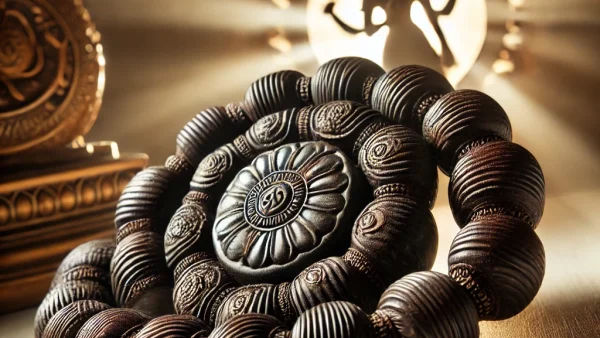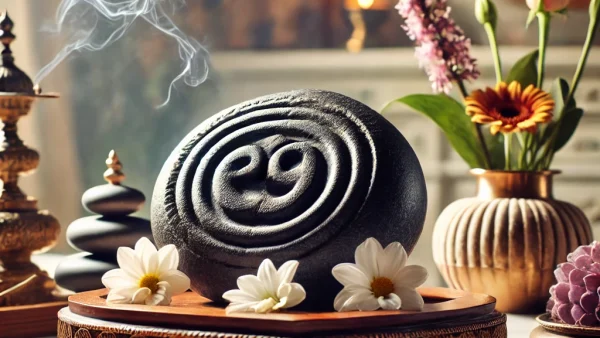The Divine Mystery of Shaligram Stones
Shaligram stones have intrigued devotees, scholars, and seekers for centuries. Nestled in the hearts of Hinduism. These sacred stones are considered manifestations of Lord Vishnu, symbolizing divine presence, protection, and prosperity. But are these revered Shaligrams simply fossils, or is there something more to them? In this blog, we’ll explore the origin, spiritual significance, and scientific perspective of Shaligram stones. Diving into the mysteries that connect them to the divine. We’ll also discuss the unique relationship between Shaligram and Vishnu and why these stones hold such an important place in the lives of Hindus and devotees of Lord Shiva and Lord Vishnu.
What Are Shaligram Stones?
Shaligram stones, also known as Salagrama, are sacred black stones found primarily in the Kali Gandaki River in Nepal. They are easily recognized by the spiral and fossil-like patterns etched onto their surface. To the devout, these stones are no ordinary rocks—they are considered divine symbols representing the presence of Lord Vishnu himself. Shaligrams are worshipped in homes, temples, and sacred shrines as symbols of power, abundance, and protection.
Are Shaligrams Fossils? The Science Behind the Sacred
To answer the question directly: yes, Shaligram stones are indeed fossils. These sacred stones are believed to be the fossilized remains of ammonites. Ancient sea-dwelling creatures that lived millions of years ago during the Devonian and Jurassic periods. Ammonites were shelled mollusks that resemble present-day nautiluses. As these creatures died, their shells were gradually buried under layers of sediment. Eventually fossilizing over millions of years to form what we now know as Shaligrams.
The Kali Gandaki River in the Himalayas is a unique geological region that was once submerged under the ocean. The area’s constant tectonic activity and the movement of the river have exposed these ancient ammonite fossils, allowing them to be found and revered by devotees. The spiral shape of the fossilized ammonites is often seen as a manifestation of Vishnu’s Sudarshan Chakra. Lending a divine element to their form.
The Spiritual Significance of Shaligrams in Hinduism
While science tells us that Shaligrams are fossilized ammonites, their importance in Hinduism extends far beyond their physical origin. To devotees, Shaligram is not just a fossil—it is a sacred embodiment of Vishnu’s energy and grace. The belief in the divine nature of Shaligram stones has roots in ancient scriptures, mythological tales, and spiritual experiences.
According to Hindu texts like the Skanda Purana and the Garuda Purana, Lord Vishnu himself resides within the Shaligram stones. The scriptures describe how Vishnu took the form of a stone in the Kali Gandaki River, bestowing his presence on Earth for the benefit of humanity. The belief is that by worshipping Shaligram, one can directly connect with Lord Vishnu, receiving blessings for health, wealth, and spiritual advancement.
Shaligram and Lord Vishnu: A Divine Connection
The relationship between Shaligram and Vishnu is deeply symbolic. The spiral markings on the Shaligram stone are often interpreted as representing the Sudarshan Chakra, Lord Vishnu’s divine weapon, which signifies the cycle of creation, preservation, and destruction. This connection serves as a reminder to devotees of Vishnu’s role in maintaining the cosmic order.
In Hindu households, Shaligrams are often placed on altars alongside idols of Vishnu and other deities. Daily worship of Shaligram involves offering water, tulsi leaves, and prayers to invoke the deity’s blessings. Tulsi, or holy basil, is considered especially significant when worshipping Shaligram, as it symbolizes the goddess Lakshmi, who is Vishnu’s divine consort. The union of Shaligram and Tulsi is seen as a representation of the cosmic couple, invoking harmony and prosperity in the worshipper’s life.
Real-Life Examples of Shaligram Worship
Shaligram worship is not limited to individual households; it also plays a significant role in temple rituals and ceremonies. In several Vishnu temples, Shaligram stones are used during special rituals, including abhishekam (sacred bathing) and puja (worship). The presence of Shaligram in these ceremonies is believed to amplify the potency of the rituals, invoking Vishnu’s blessings for all participants.
In South India, the famous Srirangam Temple—one of the largest and oldest temples dedicated to Vishnu—uses Shaligram stones in its rituals. The priests of the temple consider the Shaligram a sacred symbol that bridges the gap between the earthly and the divine, making it an essential part of temple offerings and celebrations.
Are Shaligrams Just Fossils?
Skeptics might argue that Shaligrams are merely fossils—remnants of ancient creatures with no divine significance. From a purely scientific perspective, they are correct. Shaligram stones are indeed fossilized ammonites that have undergone natural processes over millions of years.
However, the significance of Shaligram extends beyond its physical form. To understand the true value of Shaligram. One must look at it through the lens of faith, spirituality, and cultural heritage. In Hinduism, divinity often takes forms that bridge the gap between the material and the spiritual, allowing devotees to connect with higher energies through tangible symbols. Shaligram is one such symbol—one that embodies both the wonder of natural history and the profound devotion of countless believers.
How to Worship Shaligram
Worshipping Shaligram is a simple yet deeply spiritual practice. Devotees begin by cleaning the Shaligram stone with water, milk, or holy Ganga water. They then offer tulsi leaves, flowers, and incense, reciting mantras dedicated to Lord Vishnu. One commonly recited mantra during Shaligram worship is the Vishnu Gayatri Mantra:
“Om Narayanaya Vidmahe Vasudevaya Dhimahi Tanno Vishnu Prachodayat”
This mantra is believed to invoke Vishnu’s blessings and bring peace, prosperity, and protection to the devotee.
Shaligram Stones at Spiritualguru.lk
If you are interested in owning and worshipping a Shaligram stone, you can find an authentic collection available at spiritualguru.lk. At Spiritual Guru, we offer genuine Shaligram stones sourced from the sacred Kali Gandaki River. Allowing you to bring home a symbol of divine grace and connect with the energy of Lord Vishnu.
Shaligram as a Symbol of Unity
The story of Shaligram beautifully illustrates the intersection of science and spirituality. While science tells us that Shaligrams are ancient fossils. Hinduism teaches us that these fossils hold the divine energy of Vishnu. This unity of scientific understanding and spiritual belief speaks to the deeper truths of existence—that the material and the divine are not separate but are intricately connected. Offering us different ways to understand the world and our place within it.
Shaligram—A Fossil, A Deity, A Symbol of Devotion
In conclusion, Shaligram stones are indeed fossils—fossilized ammonites that have traveled through time from ancient oceans to the sacred Kali Gandaki River. Yet, they are so much more than fossils. To millions of Hindus and devotees, Shaligrams are manifestations of Lord Vishnu, sacred symbols of divine presence, and powerful sources of spiritual energy.
The journey of Shaligram—from being an ancient sea creature to becoming a revered object of worship—reminds us of the deep connection between nature, faith, and divinity. Whether you view Shaligram as a fossil or as a form of Vishnu, its significance in Hinduism is undeniable. It represents the beauty of belief, the power of devotion, and the unity of the natural and the spiritual worlds.
If you are looking to invite the divine presence of Shaligram into your home, be sure to visit spiritualguru.lk to explore our collection of authentic Shaligram stones. May your journey with Shaligram bring you closer to the divine grace of Lord Vishnu and fill your life with peace, protection, and prosperity.







Leave a comment